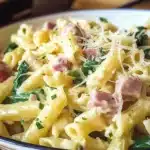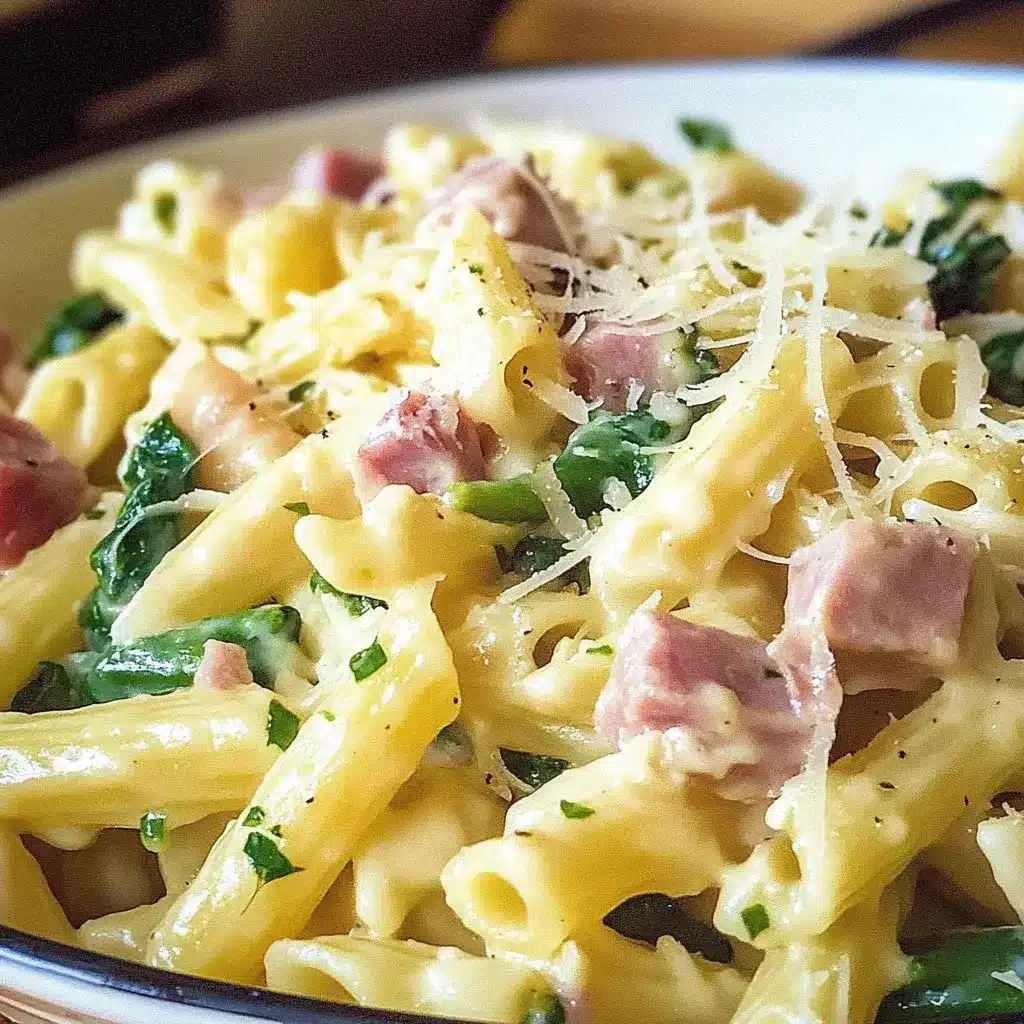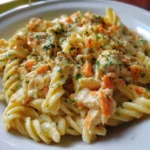Spring is in the air, and with it comes a craving for fresh, vibrant flavors that mirror the season’s rebirth. This Spring Veggie and Ham Pasta has become a staple in our home during this time of year. It’s the kind of dish that effortlessly bridges the gap between comfort food and healthy eating. Even my kids, who can be notoriously picky about vegetables, gobble this down without a fuss. The combination of tender pasta, crisp-tender spring vegetables, and savory ham is simply irresistible. It’s light enough for a warm spring evening, yet satisfying enough to be a complete meal. Honestly, this recipe is a winner – it’s quick to prepare, endlessly adaptable to whatever veggies you have on hand, and always brings smiles to the table. If you’re looking for a dish that embodies the freshness of spring and is guaranteed to be a family hit, look no further.
Ingredients: The Freshest Flavors of Spring
- Pasta: 1 pound of your favorite pasta shape. Penne, fusilli, farfalle, or rotini all work wonderfully to capture the sauce and vegetables.
- Ham: 8 ounces of cooked ham, diced. Choose a good quality ham for the best flavor; leftover holiday ham is perfect!
- Asparagus: 1 pound of fresh asparagus, trimmed and cut into 1-inch pieces. Adds a delicate, slightly grassy flavor that screams spring.
- Peas: 1 cup of frozen or fresh peas. Sweet and tender, peas are a quintessential spring vegetable.
- Snap Peas or Sugar Snap Peas: 1 cup of snap peas or sugar snap peas, trimmed and halved or left whole if small. Provide a delightful crunch and sweetness.
- Broccoli Florets: 1 cup of broccoli florets, cut into bite-sized pieces. Offers a hearty texture and earthy flavor.
- Cherry Tomatoes: 1 pint of cherry tomatoes, halved or quartered. Bursting with juicy sweetness and acidity to balance the richness.
- Garlic: 2-3 cloves of garlic, minced. Essential for building a savory flavor base.
- Olive Oil: 1/4 cup of extra virgin olive oil. Used for sautéing vegetables and adding richness to the sauce.
- Chicken Broth or Vegetable Broth: 1/2 cup of low-sodium chicken or vegetable broth. Adds moisture and flavor to the sauce.
- Heavy Cream or Half-and-Half (optional): 1/4 cup of heavy cream or half-and-half (optional). For a richer, creamier sauce. Can be omitted for a lighter dish.
- Parmesan Cheese: 1/2 cup of grated Parmesan cheese, plus extra for serving. Adds salty, savory, and nutty notes to the pasta.
- Fresh Lemon Juice: 1 tablespoon of fresh lemon juice. Brightens the dish and enhances the spring flavors.
- Fresh Herbs: 1/4 cup of chopped fresh herbs like parsley, chives, basil, or dill. Adds freshness and aromatic complexity. Parsley and chives are particularly great for spring dishes.
- Salt and Black Pepper: To taste. Essential for seasoning and balancing flavors.
- Red Pepper Flakes (optional): A pinch of red pepper flakes (optional). For a subtle kick of heat.
Instructions: Step-by-Step Guide to Deliciousness
- Cook the Pasta: Bring a large pot of salted water to a boil. Add the pasta and cook according to package directions until al dente. Reserve about 1 cup of pasta water before draining. Drain the pasta and set aside.
- Sauté the Garlic and Ham: While the pasta is cooking, heat the olive oil in a large skillet or Dutch oven over medium heat. Add the minced garlic and cook for about 30 seconds, or until fragrant, being careful not to burn it. Add the diced ham to the skillet and cook for 2-3 minutes, or until lightly browned and heated through. This step helps to enhance the savory flavor of the ham and garlic.
- Add the Vegetables (Broccoli and Asparagus): Add the broccoli florets and asparagus pieces to the skillet with the ham and garlic. Sauté for 3-4 minutes, stirring occasionally, until the broccoli is bright green and slightly tender-crisp, and the asparagus is tender but still has a slight bite. Don’t overcook the vegetables at this stage; they will cook further with the pasta and sauce.
- Incorporate Peas and Snap Peas: Add the peas and snap peas (or sugar snap peas) to the skillet. If using frozen peas, cook for about 2-3 minutes until heated through and bright green. If using fresh peas, they may need slightly longer. Snap peas will only need a minute or two to warm up and retain their crispness.
- Add Tomatoes and Broth: Stir in the halved or quartered cherry tomatoes and cook for another 2-3 minutes, until they begin to soften and release some of their juices. Pour in the chicken or vegetable broth and bring to a gentle simmer. The broth will help to create a light sauce and bring all the flavors together.
- Create a Creamy Sauce (Optional): If using, stir in the heavy cream or half-and-half. Reduce the heat to low and simmer for a minute or two, allowing the sauce to slightly thicken. If you prefer a lighter sauce, you can skip this step.
- Combine Pasta and Vegetables: Add the cooked and drained pasta to the skillet with the vegetables and sauce. Toss gently to combine, ensuring the pasta is evenly coated with the sauce and vegetables. If the pasta seems dry, add a little of the reserved pasta water to loosen it up and create a more luscious sauce.
- Stir in Cheese and Herbs: Stir in the grated Parmesan cheese and chopped fresh herbs. Toss again to combine. The Parmesan will melt into the sauce, adding richness and flavor. The fresh herbs will brighten the dish and add a final touch of freshness.
- Season and Finish: Season the pasta with salt and black pepper to taste. Add a pinch of red pepper flakes if desired for a little heat. Stir in the fresh lemon juice to brighten the flavors and balance the richness. Taste and adjust seasoning as needed.
- Serve Immediately: Serve the Spring Veggie and Ham Pasta immediately, garnished with extra grated Parmesan cheese and fresh herbs, if desired. This dish is best enjoyed fresh while the vegetables are still vibrant and the pasta is perfectly al dente.
Nutrition Facts: A Wholesome and Satisfying Meal
(Please note: Nutritional information is an estimate and can vary based on specific ingredients and portion sizes.)
Servings: Approximately 6 servings
Calories per Serving: Approximately 550-650 calories (depending on pasta type, cream usage, and portion size)
- Protein: 25-30g
- Carbohydrates: 70-80g
- Fat: 20-25g (can be lower if cream is omitted and olive oil is used sparingly)
- Fiber: 8-10g
- Vitamin C: Excellent source (from vegetables)
- Vitamin K: Good source (from green vegetables)
Preparation Time: Quick and Easy Spring Dinner
This Spring Veggie and Ham Pasta is wonderfully efficient, making it perfect for a weeknight meal or a relaxed weekend lunch.
- Prep Time: 20 minutes (chopping vegetables, dicing ham, mincing garlic)
- Cook Time: 25 minutes (cooking pasta, sautéing vegetables, simmering sauce)
- Total Time: Approximately 45 minutes
From start to finish, you can have a delicious and vibrant spring pasta dish on the table in under an hour! This quick preparation time makes it a fantastic option for busy individuals and families who still want to enjoy a homemade, healthy, and flavorful meal.
How to Serve Your Spring Veggie and Ham Pasta
This versatile pasta dish can be served in various ways, making it suitable for different occasions. Here are some serving suggestions:
- As a Main Course: Serve generous portions of the pasta as a satisfying and complete main course. It’s hearty enough to stand alone for dinner or lunch.
- With a Side Salad: Pair the pasta with a light and refreshing side salad. A simple green salad with a vinaigrette dressing complements the richness of the pasta and adds extra vegetables.
- Garlic Bread or Crusty Bread: Serve with warm garlic bread or crusty bread for soaking up the delicious sauce. A slice of toasted baguette drizzled with olive oil would also be lovely.
- Grilled Chicken or Fish: For a more substantial meal, you can serve a smaller portion of the pasta alongside grilled chicken breast, baked salmon, or pan-seared shrimp. This adds extra protein and variety.
- As a Potluck Dish: This pasta is excellent for potlucks and gatherings. It travels well and can be served warm or at room temperature.
- Garnishes: Enhance the presentation and flavor with extra garnishes:
- Freshly grated Parmesan cheese: Always a welcome addition for extra cheesy flavor.
- Chopped fresh herbs: Sprinkle with more parsley, chives, basil, or dill before serving for a fresh aroma and visual appeal.
- Lemon wedges: Offer lemon wedges on the side so people can add an extra squeeze of lemon juice to brighten their portion.
- Red pepper flakes: For those who like a little heat, provide extra red pepper flakes on the table.
Additional Tips for Perfect Spring Pasta
To ensure your Spring Veggie and Ham Pasta is a resounding success, consider these helpful tips:
- Don’t Overcook the Pasta: Cook the pasta al dente – it should be firm to the bite. Overcooked pasta will become mushy and less appealing in the dish. Remember it will continue to cook slightly when combined with the hot sauce.
- Use Fresh, Seasonal Vegetables: Spring vegetables are at their peak flavor during this season. Utilize what’s fresh and available at your local farmers market or grocery store for the best taste. Feel free to substitute vegetables based on seasonality and your preferences (e.g., zucchini, bell peppers, artichoke hearts).
- Toast the Garlic Gently: Sauté the minced garlic over medium-low heat and watch it carefully. You want it to become fragrant and lightly golden, but not brown or burnt, as burnt garlic will taste bitter.
- Don’t Overcrowd the Skillet: When sautéing the vegetables, make sure not to overcrowd the skillet. Overcrowding will steam the vegetables instead of sautéing them, resulting in less flavorful and less nicely textured vegetables. Cook in batches if necessary.
- Reserve Pasta Water: Always reserve some pasta water before draining. This starchy water is a fantastic tool for adjusting the consistency of your sauce and helping it cling to the pasta. Add it gradually until you reach your desired sauce consistency.
- Taste and Season as You Go: Season each layer of flavor as you build the dish. Season the pasta water, season the vegetables while sautéing, and season the final dish. Tasting and adjusting seasoning at each stage ensures a well-balanced and flavorful outcome.
- Customize with Protein: While ham is classic in this recipe, you can easily adapt it with other proteins. Consider using cooked chicken, shrimp, Italian sausage (removed from casings and browned), or even chickpeas for a vegetarian option.
- Make it Vegetarian or Vegan: To make this recipe vegetarian, simply omit the ham. For a vegan version, omit the ham and Parmesan cheese, and use a plant-based cream alternative or nutritional yeast for cheesy flavor. Ensure you are using vegetable broth.
Frequently Asked Questions About Spring Veggie and Ham Pasta
Q1: Can I use different vegetables in this pasta?
A: Absolutely! This recipe is very adaptable. Feel free to use other spring vegetables like zucchini, bell peppers, fiddleheads (if you can find them and know how to prepare them), or even roasted asparagus. You can also add greens like spinach or arugula towards the end of cooking.
Q2: Can I make this pasta ahead of time?
A: While this pasta is best enjoyed fresh, you can prepare components ahead of time. You can chop the vegetables and dice the ham in advance. The cooked pasta and sauce are best when combined just before serving to prevent the pasta from becoming soggy and the vegetables from overcooking. If you must make it ahead, slightly undercook the pasta and add a bit more sauce to keep it moist when reheating.
Q3: How do I store leftover Spring Veggie and Ham Pasta?
A: Store leftover pasta in an airtight container in the refrigerator for up to 3 days. Reheat gently in a skillet over medium-low heat or in the microwave, adding a splash of broth or water to moisten it as needed.
Q4: Can I freeze this pasta?
A: Freezing cooked pasta dishes with vegetables can sometimes alter the texture of the vegetables and pasta, making them softer. However, if you need to freeze it, allow the pasta to cool completely, then freeze in airtight containers for up to 2 months. Thaw in the refrigerator overnight and reheat gently. Be aware that the texture might be slightly different after freezing and thawing.
Q5: I don’t have ham. What else can I use?
A: If you don’t have ham, you can substitute it with cooked chicken, Italian sausage (browned and crumbled), bacon (cooked and crumbled), or even pancetta. For a vegetarian option, you can omit the ham entirely or add white beans or chickpeas for protein.
Q6: Can I make this pasta creamier?
A: Yes, if you prefer a creamier pasta, you can increase the amount of heavy cream or half-and-half. You can also add a tablespoon of cream cheese or mascarpone cheese to the sauce for extra richness and creaminess. Stir it in at the end until melted and smooth.
Q7: Is this recipe gluten-free?
A: No, traditional pasta is not gluten-free. However, you can easily make this recipe gluten-free by using gluten-free pasta. Ensure all other ingredients are also gluten-free, although naturally, most of the other ingredients are.
Q8: Can I add cheese other than Parmesan?
A: Absolutely! Pecorino Romano, Asiago, or even a blend of Italian cheeses would work well in this pasta. You can also add a sprinkle of fresh ricotta or goat cheese on top of each serving for a different flavor profile. Experiment and find your favorite cheese combination!

Spring Veggie and Ham Pasta
Ingredients
- Pasta: 1 pound of your favorite pasta shape. Penne, fusilli, farfalle, or rotini all work wonderfully to capture the sauce and vegetables.
- Ham: 8 ounces of cooked ham, diced. Choose a good quality ham for the best flavor; leftover holiday ham is perfect!
- Asparagus: 1 pound of fresh asparagus, trimmed and cut into 1-inch pieces. Adds a delicate, slightly grassy flavor that screams spring.
- Peas: 1 cup of frozen or fresh peas. Sweet and tender, peas are a quintessential spring vegetable.
- Snap Peas or Sugar Snap Peas: 1 cup of snap peas or sugar snap peas, trimmed and halved or left whole if small. Provide a delightful crunch and sweetness.
- Broccoli Florets: 1 cup of broccoli florets, cut into bite-sized pieces. Offers a hearty texture and earthy flavor.
- Cherry Tomatoes: 1 pint of cherry tomatoes, halved or quartered. Bursting with juicy sweetness and acidity to balance the richness.
- Garlic: 2-3 cloves of garlic, minced. Essential for building a savory flavor base.
- Olive Oil: 1/4 cup of extra virgin olive oil. Used for sautéing vegetables and adding richness to the sauce.
- Chicken Broth or Vegetable Broth: 1/2 cup of low-sodium chicken or vegetable broth. Adds moisture and flavor to the sauce.
- Heavy Cream or Half-and-Half (optional): 1/4 cup of heavy cream or half-and-half (optional). For a richer, creamier sauce. Can be omitted for a lighter dish.
- Parmesan Cheese: 1/2 cup of grated Parmesan cheese, plus extra for serving. Adds salty, savory, and nutty notes to the pasta.
- Fresh Lemon Juice: 1 tablespoon of fresh lemon juice. Brightens the dish and enhances the spring flavors.
- Fresh Herbs: 1/4 cup of chopped fresh herbs like parsley, chives, basil, or dill. Adds freshness and aromatic complexity. Parsley and chives are particularly great for spring dishes.
- Salt and Black Pepper: To taste. Essential for seasoning and balancing flavors.
- Red Pepper Flakes (optional): A pinch of red pepper flakes (optional). For a subtle kick of heat.
Instructions
- Cook the Pasta: Bring a large pot of salted water to a boil. Add the pasta and cook according to package directions until al dente. Reserve about 1 cup of pasta water before draining. Drain the pasta and set aside.
- Sauté the Garlic and Ham: While the pasta is cooking, heat the olive oil in a large skillet or Dutch oven over medium heat. Add the minced garlic and cook for about 30 seconds, or until fragrant, being careful not to burn it. Add the diced ham to the skillet and cook for 2-3 minutes, or until lightly browned and heated through. This step helps to enhance the savory flavor of the ham and garlic.
- Add the Vegetables (Broccoli and Asparagus): Add the broccoli florets and asparagus pieces to the skillet with the ham and garlic. Sauté for 3-4 minutes, stirring occasionally, until the broccoli is bright green and slightly tender-crisp, and the asparagus is tender but still has a slight bite. Don’t overcook the vegetables at this stage; they will cook further with the pasta and sauce.
- Incorporate Peas and Snap Peas: Add the peas and snap peas (or sugar snap peas) to the skillet. If using frozen peas, cook for about 2-3 minutes until heated through and bright green. If using fresh peas, they may need slightly longer. Snap peas will only need a minute or two to warm up and retain their crispness.
- Add Tomatoes and Broth: Stir in the halved or quartered cherry tomatoes and cook for another 2-3 minutes, until they begin to soften and release some of their juices. Pour in the chicken or vegetable broth and bring to a gentle simmer. The broth will help to create a light sauce and bring all the flavors together.
- Create a Creamy Sauce (Optional): If using, stir in the heavy cream or half-and-half. Reduce the heat to low and simmer for a minute or two, allowing the sauce to slightly thicken. If you prefer a lighter sauce, you can skip this step.
- Combine Pasta and Vegetables: Add the cooked and drained pasta to the skillet with the vegetables and sauce. Toss gently to combine, ensuring the pasta is evenly coated with the sauce and vegetables. If the pasta seems dry, add a little of the reserved pasta water to loosen it up and create a more luscious sauce.
- Stir in Cheese and Herbs: Stir in the grated Parmesan cheese and chopped fresh herbs. Toss again to combine. The Parmesan will melt into the sauce, adding richness and flavor. The fresh herbs will brighten the dish and add a final touch of freshness.
- Season and Finish: Season the pasta with salt and black pepper to taste. Add a pinch of red pepper flakes if desired for a little heat. Stir in the fresh lemon juice to brighten the flavors and balance the richness. Taste and adjust seasoning as needed.
- Serve Immediately: Serve the Spring Veggie and Ham Pasta immediately, garnished with extra grated Parmesan cheese and fresh herbs, if desired. This dish is best enjoyed fresh while the vegetables are still vibrant and the pasta is perfectly al dente.
Nutrition
- Serving Size: one normal portion
- Calories: 650
- Fat: 25g
- Carbohydrates: 80g
- Fiber: 10g
- Protein: 30g






